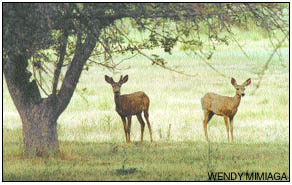|
Nov. 11, 2000 By Janelle Holden
Hunters a field in snowy weather will be aiming at a healthier deer population this year. "My take is that the number of deer overall are increasing almost everywhere across western Colorado," said Jim Olterman, the Colorado Division of Wildlife’s senior wildlife biologist for Western Colorado. Olterman explained that since the DOW reduced the amount of hunting licenses the older, more mature, deer population has expanded and the hunter-success rate has gone up "dramatically." This is due, in part, to mild winters. Since 1997 the winter habitat has supported a larger amount of deer. The DOW determines the deer population by constructing a computer model of the number of fawns and bucks per 100 in the population. For the local area, this information consists of units 72 and 73, which run from the Utah and New Mexico borders to the La Plata mountain range and the town of Dolores. The DOW estimated last winter that there were 10,500 deer in western Colorado. "I really think the population is on the increase and we’re around what our long-term objective is for deer here," said Olterman. These numbers are also dependent on fawn survival, which Olterman said he’s "almost certain is going to be up." Southwestern Colorado’s habitat can support 30 to 40 deer per square mile. The deer population was at its lowest in 1996, with an estimated 8,000 head in the backcountry. Many deer died because of an outbreak of a viral disease known as blue tongue that is spread by gnats. The disease originated in domestic sheep, and although it has little effect on sheep or humans it’s usually fatal for deer. Many of the dead deer in Montezuma County were found in McElmo Canyon. The other primary disease that kills deer, chronic wasting disease, has not yet been transferred to deer in Western Colorado. Besides humans, coyotes and mountain lions are the two main predators of deer in the area, but predator populations have stayed level, Olterman said. "Predator populations are driven by social interaction," he said. "They only get to a certain level and they just don’t tolerate each other any more." Western Colorado’s last deer-hunting season this year ends on Wednesday, Nov. 15. |
||||
|
Copyright © 2000 the Cortez Journal.
All rights reserved. |
